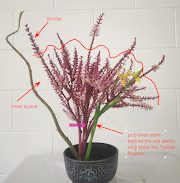Contrast 1 - Task, 18 July 2020
Topic: Contrast 1
Ikebana Aesthetics Program - Zoom Ikebana Dojo
⬦⬦⬦⬦⬦⬦⬦⬦⬦⬦⬦⬦⬦⬦⬦⬦⬦⬦⬦⬦⬦⬦⬦⬦⬦
Video Tutorial: Please follow our site or subscribe our Youtube Channel.
⬦⬦⬦⬦⬦⬦⬦⬦⬦⬦⬦⬦⬦⬦⬦⬦⬦⬦⬦⬦⬦⬦⬦⬦⬦
Contrast is just like Wasabi in Japanese cuisine. Ikebana without contrast is so boring!
Contrast is the juxtaposition of different design elements, for example, dark and light values, or high and low density. There are 4 points we want you to learn in Contrast 1.
1. In ikebana we may just say light and heavy, weak and strong or soft and hard. Such simple terms are enough to understand the basics of Ikebana Aesthetics.
2. Understand the difference between strong contrast, weak contrast & no contrast.
Compare the two designs above, A & B. A is a combination of two similar shapes, and B is a combination of two different shapes. We feel a strong contrast in A because the difference (colour) is highlighted while other elements (shape & size) are unified. There is weak or no contrast in B, because the two elements (star & circle) are different in shape as well as colour. To create strong contrast, emphasise a difference while maintaining some similarities between the two elements. Contrast emerges when the two elements are different but related. This tip maybe a bit advanced for some, but many of you will soon realise how helpful this is in creating poetic Ikebana.
3. High & Low density is one of the most important types of contrast in Ikebana in order to create poetry. We will look into this aspect further in Contrast 2 & 3.
4. Be aware of the purpose of contrast. It is not just to highlight the differences but also to create a focal point. We will look into this aspect further in Contrast 2 & 3.
For more about Contrast in ikebana, refer to a short essay, "Introduction to Ikebana Aesthetics" by Dr Shoso Shimbo (available shortly in English & Japanese).
Analysis - Sample Work

In the sample, you can see high density at the base of the arrangement (1), and scattered low density toward the outer end of leaves (2).
The contrast in the sample work suggests strong energy exploding from the base of the arrangement toward outside (blue arrows).
Task
Your task this time is to create contrast of density using long leaves. It's so simple but notice how contrast can create the flow of living energy.
If you are an advanced student, incorporate more design elements while focusing on the contrast of density as the main feature.
What You Need
1. Secateurs
2. Kenzan or florist foam or wire packed container (see Balance 1 and Movement 1)
3. Container - any include a cup. Find a container that suits your materials.
4. Stapler
5. Flower materials:
a. A few long leaves such as Spanish Iris. Find leaves that are soft and easy to manipulate.
b. Lisianthus or any other flower.
Flower materials are guide only. You can choose any other materials as long as you focus on the topic.
How to Make It?
- Make three sets of loops from your long leaves. Use a stapler to fix the size of your loop. You can make a single loop, or you can loop your leaf around 2 or 3 times.
If there are 2 loops, the ratio of each loop’s diameter should be about 7: 3.
This is one of the magic numbers in Ikebana Aesthetics. For more details, refer to a short essay, "Introduction to Ikebana Aesthetics" by Dr Shoso Shimbo (available shortly in English & Japanese).
2. Fix your sets of leaves on the Kenzan. They should be as close as possible.
3. Adjust the leaves so that you can create contrast of density.
4. Add flowers of your choice at the base of your leaf structure. Don’t use too much flower material.
5. Check the overall balance. Hide the base using flowers or their foliage.
What's Next? - Get Feedback
1. Book to join Zoom Ikebana Dojo. Use the application form on the page. Follow the instructions on the page.
2. Join Zoom Ikebana Dojo on 18 July 2020. Send your photo to our facilitator. Enjoy friendly feedback from our facilitator and other participants.
3. Post you work to Ikebana Gallery Award.
Samples for Advanced Students
References





























